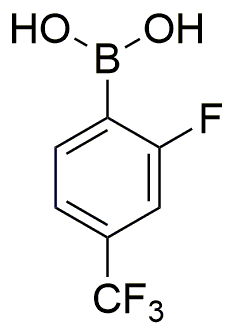2-Fluoro-4-(trifluoromethyl)phenylboronic acid is widely utilized in research focused on:
- Pharmaceutical Development: This compound plays a crucial role in the synthesis of various pharmaceuticals, particularly in the development of drugs targeting specific biological pathways.
- Organic Synthesis: It serves as a versatile building block in organic chemistry, enabling the creation of complex molecules through cross-coupling reactions, which are essential in producing agrochemicals and fine chemicals.
- Material Science: The compound is used in the formulation of advanced materials, including polymers and coatings, enhancing their properties such as durability and resistance to environmental factors.
- Fluorine Chemistry: Its unique fluorinated structure makes it valuable in fluorine chemistry, allowing researchers to explore new pathways for creating fluorinated compounds with improved performance in various applications.
- Analytical Chemistry: This chemical is utilized in analytical methods for detecting and quantifying specific compounds, providing accurate results that are crucial for quality control in various industries.
General Information
Properties
Safety and Regulations
Applications
2-Fluoro-4-(trifluoromethyl)phenylboronic acid is widely utilized in research focused on:
- Pharmaceutical Development: This compound plays a crucial role in the synthesis of various pharmaceuticals, particularly in the development of drugs targeting specific biological pathways.
- Organic Synthesis: It serves as a versatile building block in organic chemistry, enabling the creation of complex molecules through cross-coupling reactions, which are essential in producing agrochemicals and fine chemicals.
- Material Science: The compound is used in the formulation of advanced materials, including polymers and coatings, enhancing their properties such as durability and resistance to environmental factors.
- Fluorine Chemistry: Its unique fluorinated structure makes it valuable in fluorine chemistry, allowing researchers to explore new pathways for creating fluorinated compounds with improved performance in various applications.
- Analytical Chemistry: This chemical is utilized in analytical methods for detecting and quantifying specific compounds, providing accurate results that are crucial for quality control in various industries.
Documents
Safety Data Sheets (SDS)
The SDS provides comprehensive safety information on handling, storage, and disposal of the product.
Product Specification (PS)
The PS provides a comprehensive breakdown of the product’s properties, including chemical composition, physical state, purity, and storage requirements. It also details acceptable quality ranges and the product's intended applications.
Certificates of Analysis (COA)
Search for Certificates of Analysis (COA) by entering the products Lot Number. Lot and Batch Numbers can be found on a product’s label following the words ‘Lot’ or ‘Batch’.
*Catalog Number
*Lot Number
Certificates Of Origin (COO)
This COO confirms the country where the product was manufactured, and also details the materials and components used in it and whether it is derived from natural, synthetic, or other specific sources. This certificate may be required for customs, trade, and regulatory compliance.
*Catalog Number
*Lot Number
Safety Data Sheets (SDS)
The SDS provides comprehensive safety information on handling, storage, and disposal of the product.
DownloadProduct Specification (PS)
The PS provides a comprehensive breakdown of the product’s properties, including chemical composition, physical state, purity, and storage requirements. It also details acceptable quality ranges and the product's intended applications.
DownloadCertificates of Analysis (COA)
Search for Certificates of Analysis (COA) by entering the products Lot Number. Lot and Batch Numbers can be found on a product’s label following the words ‘Lot’ or ‘Batch’.
*Catalog Number
*Lot Number
Certificates Of Origin (COO)
This COO confirms the country where the product was manufactured, and also details the materials and components used in it and whether it is derived from natural, synthetic, or other specific sources. This certificate may be required for customs, trade, and regulatory compliance.


